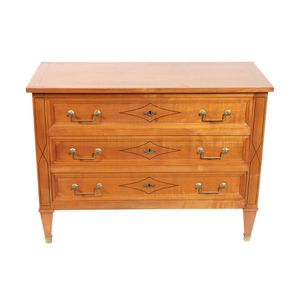
Cherrywood Chest with Ebony Inlay and Brass Fittings
Directoire style chest of drawers, 20th century, cherrywood three drawers with ebony string inlay and brass fittings, height 81 cm, width 110 cm, depth 48 cm

Directoire Marble Top Commode with Gilt Bronze Mounts
A French Directoire period gilt bronze mounted parquetry inlaid marble top commode, late 18th/19th century 90 cm high, 145 cm wide, 65 cm deep

French Directoire Mahogany Commode by L. Boudin, 18th Century
Attributed to Leonard Boudin (French, 1735-1807), French Directoire plum pudding mahogany commode, late 18th century, the rectangular moulded grey marble top with eared corners, above three short and two long panelled drawers, flanked by fluted pilasters,…

Directoire Mahogany Commode with Marble Top and Gilded Brass Details
French Directoire mahogany commode, 19th century, the shaped rectangular marble top above three short drawers and two long drawers with gilded brass escutcheons and pulls, on fluted legs, height 84 cm, width 125 cm, depth 57 cm. Provenance: Christopher…

Directoire Mahogany Commode with Marble Top
A Directoire style mahogany commode, late 19th century, with a white marble top with ear form extensions above extended fluted, pillars, three long drawers with flame mahogany bookend reserves and raised, on tapering legs, with brass escutcheons and…

Directoire Tulipwood Commode with Geometric Inlay
A small Directoire tulipwood commode, 19th century, with a grey white marble top above three long drawers each decorated with geometric inlaid barber's pole bands and stringing so as to present as an arrangement of multiple small drawers, raised on…

Directoire Marble Top Walnut Commode, French 19th Century
A Directoire period marble top walnut commode, French, 19th century, 96 cm high, 128 cm wide, 57 cm deep

French Directoire Brass Mounted Mahogany Commode
A French Directoire brass mounted mahogany commode, circa 1800, the eared Gris Sainte Anne rectangular marble top over three short and two long drawers, 89 cm high, 128 cm wide, 60 cm deep. Provenance: Purchased MDRS Antiquities - Michel Ruis, Saint Ouen,…

Fruitwood Chest with Diamond Inlay, Two Drawers
Directoire fruitwood chest of drawers having two recessed long drawers, diamond inlay motif. Height 77 cm. Width 96 cm. Diameter 51 cm

Mahogany and Brass Mounted Directoire Commode
A Directoire mahogany and brass mounted commode, the grey marble top above three graduating drawers flanked by fluted rounded pilasters on toupie feet. Width 127 cm. Depth 59 cm. Height 88 cm
 Loading more...
Loading more...